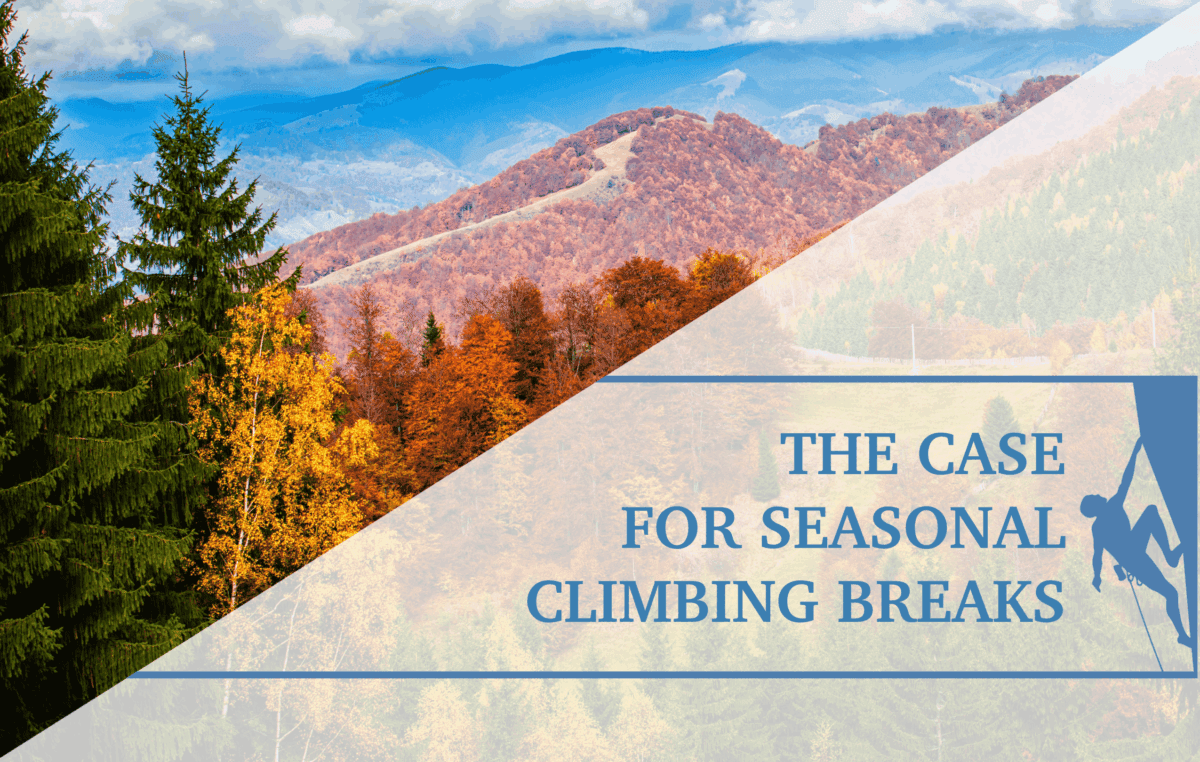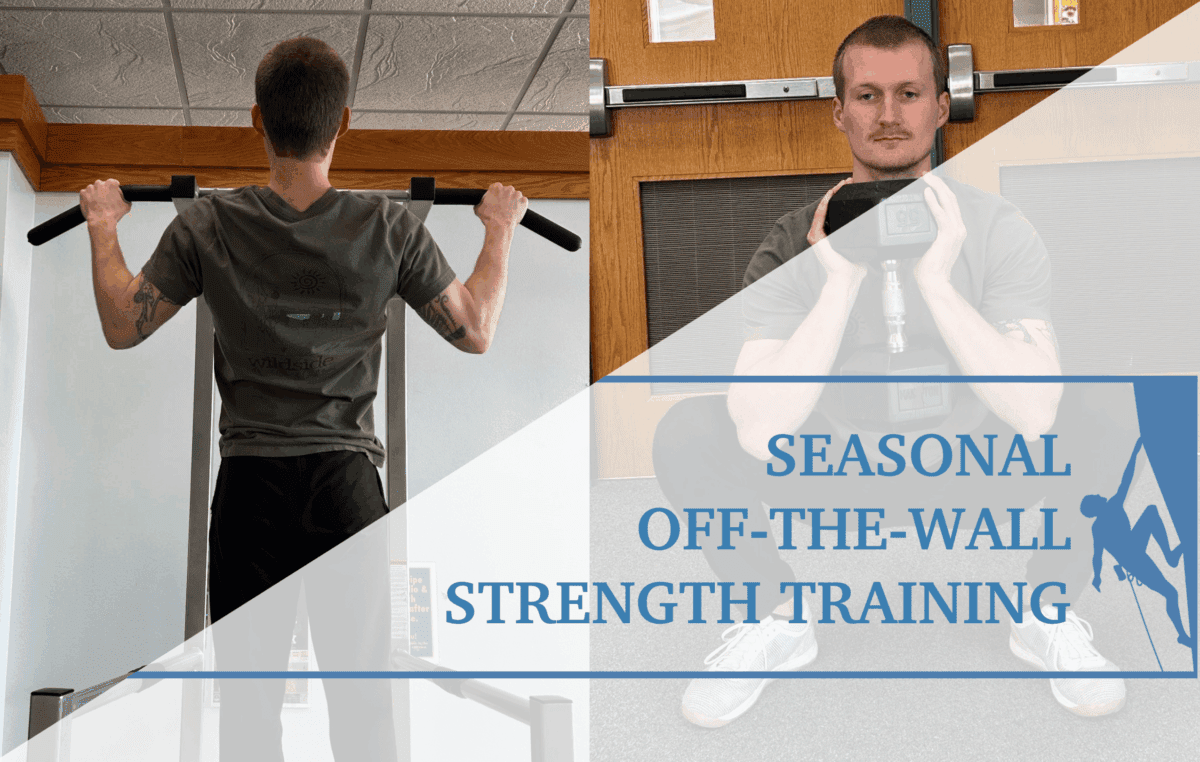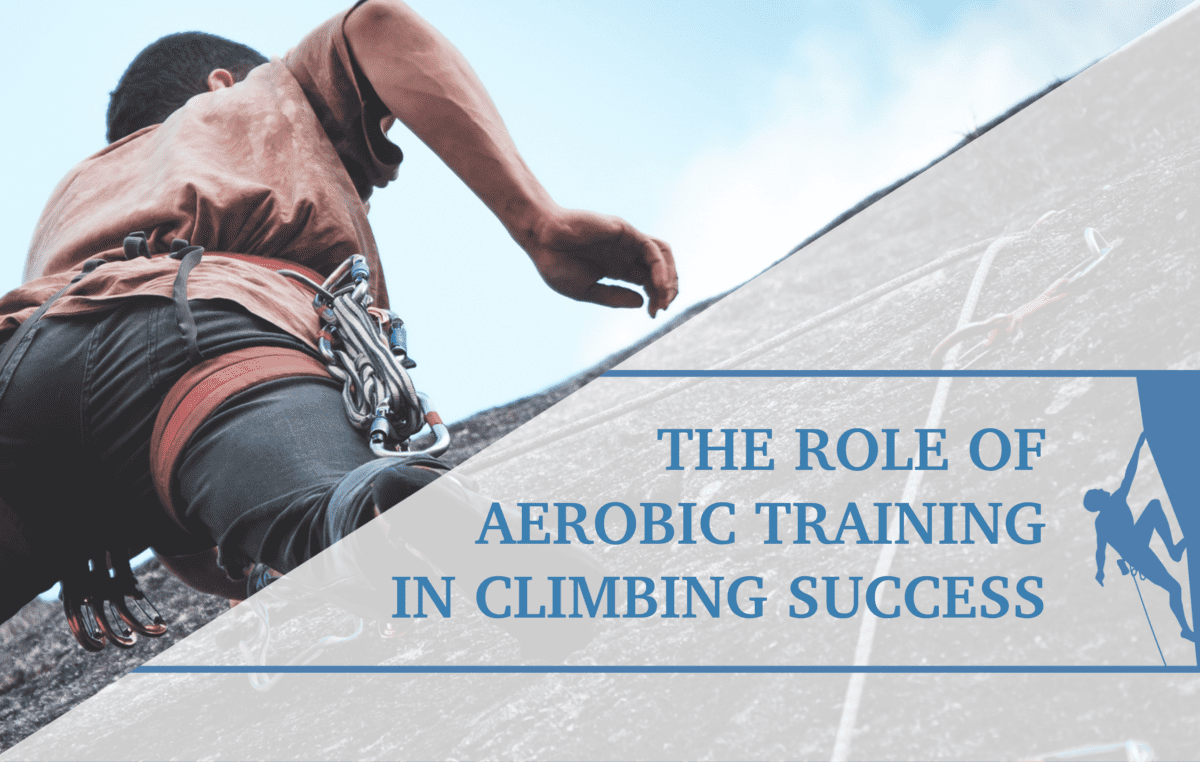Energy System Training with Limited Resources
Case Study: you are a former dirtbag climber who is now 30-40 something, has a “respectable” full time job, a 3-year-old, and a 6-month-old. Your primary proper noun is now Mom/Dad, rather than “Climber”. You live in an area of the country that has world class climbing —2 hours away— and the closest gym is 1 hour away; in other words, so close but so far when you have 2 young children. You do not have the space or money for a home wall. You still live to climb and think about it every single day. How do you stay strong, conditioned, and resilient for the handful of climbing trips, or maybe even just a few days, scattered throughout the year? How does one, with such limited resources, at least maintain fitness, so that when you do get to a crag you aren’t struggling, frustrated, quickly burnt-out or at an increased risk of injury?
The reality is that unless you are a pro climber, have lots of free time, work in the climbing industry or live next door to a gym/crag you probably have responsibilities outside of your sport which will often dominate your life, leaving little time or energy for climbing or even training. This article attempts to explain and simplify training, specifically Energy Systems Training (EST), for those climbers with limited resources, be that time, access and/or equipment, so that when you do get a chance to climb, you are as ready as you can be to put forth your best effort and send.
I think at this point the obligatory skill-development-and-movement-economy-are-what-improves-your-climbing statement should be made, and this is absolutely true. When resources are available most of your training time should be on the wall/rock, and this should be supplemented with specific hangboard, system wall or synergist/antagonist training. However, it should be noted that 52-70% of total variance in climbing ability is related to specific finger strength and training variables (interestingly, only 0.3% is related to anthropometrics and 1.8% flexibility), and strength can only be developed through overloading the body’s tissues1,2,3. Once you reach a certain grade of climbing difficulty, “just climbing” is not enough. In fact, both campus training and single arm isometric hangs have been proven to be more effective than climbing/bouldering in improving the average and early phase rate of force development3. Additionally, with certain types of EST, you are training to exhaustion and momentary muscle failure, doing this while climbing may result in injury or at the very least result in the programming of poor motor patterns, thereby defeating the purpose of training skill and coordination.
Prior to discussing energy systems and how to train them, a brief review of the different types of muscle contractions, muscle fiber types, and which ones we use when climbing is in order.
There are 3 types of muscle contractions:

- Isometric: This is a contraction where there is no significant change in the length of the muscle, you are pushing/pulling against an immovable object or holding a position, such as with hangboarding.
- Concentric: Think of actively lifting a load, your muscle is shortening. An example would be performing a pull-up.
- Eccentric: When you are lowering a load that you’ve lifted, your muscle is lengthening, such as when you are lowering from a pull-up.
Climbing is predominantly an isometric sport, especially when we focus on just the forearm and hand muscles. However, even when we consider the entire body, approximately 38% of lead climbing and 25% of bouldering time is spent statically4, 5, 7, 8, 9. Hand and forearm musculature support 43-62% of our body-weight, depending on wall angle, and perform continuous, rhythmic isometric contractions with men averaging 7 seconds and women 8.5 seconds per hold during lead climbing2, 9, 10. This would likely be why, with many hangboard repeater programs, you are hanging for about 7 seconds on and 3 seconds off, or some other similar combination. We can further categorize isometric contractions into 2 different kinds:
- Yielding: Traditional hangboarding, where you are holding a position and resisting an eccentric, or opening, force on your fingers.
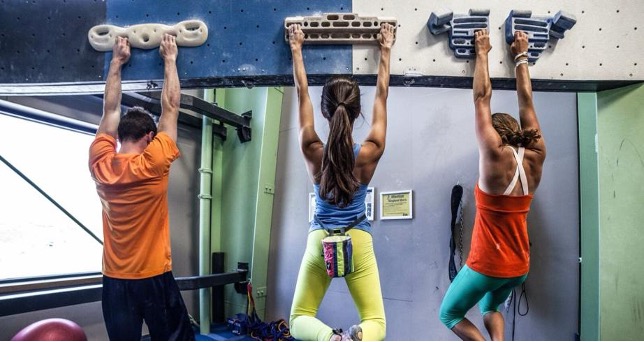
- Overcoming: “No-Hang” board training, when you are sitting/standing and exerting a pulling force on an immovable object. This would be more of a concentric contraction, but with no actual movement.

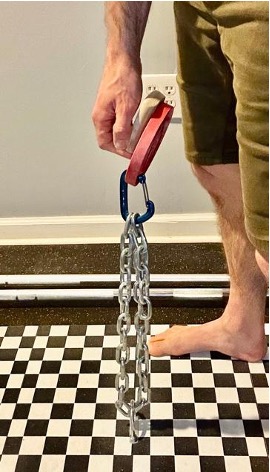

Muscle Fiber Types
The most familiar way to categorize muscle fiber types is slow- and fast-twitch. Slow-twitch motor units are small, develop force and relax slowly, and have a long twitch time, whereas fast-twitch units are bigger, develop force and relax rapidly, and thus have a shorter twitch time. Each of these fiber types can be classified with much greater detail, but for the scope of this article “fast-” and “slow-” twitch are good enough. Slow-twitch fiber types tend to be efficient and fatigue resistant, have a high capacity for aerobic energy supply and limited potential for rate of force development and anaerobic power; we will call these our “endurance fibers.” Fast-twitch, in contrast, are inefficient and fatigable, have lower aerobic power but have rapid force development and high anaerobic power; we can refer to these as our “sprint and strength fibers.” Most muscles have a combination of both types, with certain muscles having more of one type than the other, depending on what the muscle is used for11. These fiber types are not recruited randomly to increase force, but are usually recruited according to their size, with smaller slow-twitch units being recruited first, followed by larger fast-twitch fibers. Simply put, in order to recruit and develop your “sprint and strength” muscle fibers you need to activate all your “endurance” fibers first, and this can only be achieved with higher intensity loading. Let me emphasize this last statement as it will come into play when we discuss training: when you train at higher intensities, you are using both endurance AND strength muscle fibers12.
When discussing the body’s energy systems, it can get complicated and explanations can get long, but we are into brevity around here, so what is basically being referred to are the metabolic pathways which produce and replenish the energy within our muscles that are used for contractions.
Energy System Pathways
There are three pathways:
- Anaerobic Alactic: ATP – Creatine Phosphate; Immediate Energy (~1-12 seconds)
- Anaerobic Lactic: Glycolytic; Short Term Energy (~12 seconds to 2 minutes)
- Aerobic: Oxidative – Mitochondrial Respiration; Long Term Energy (~2 minutes to Hours)11
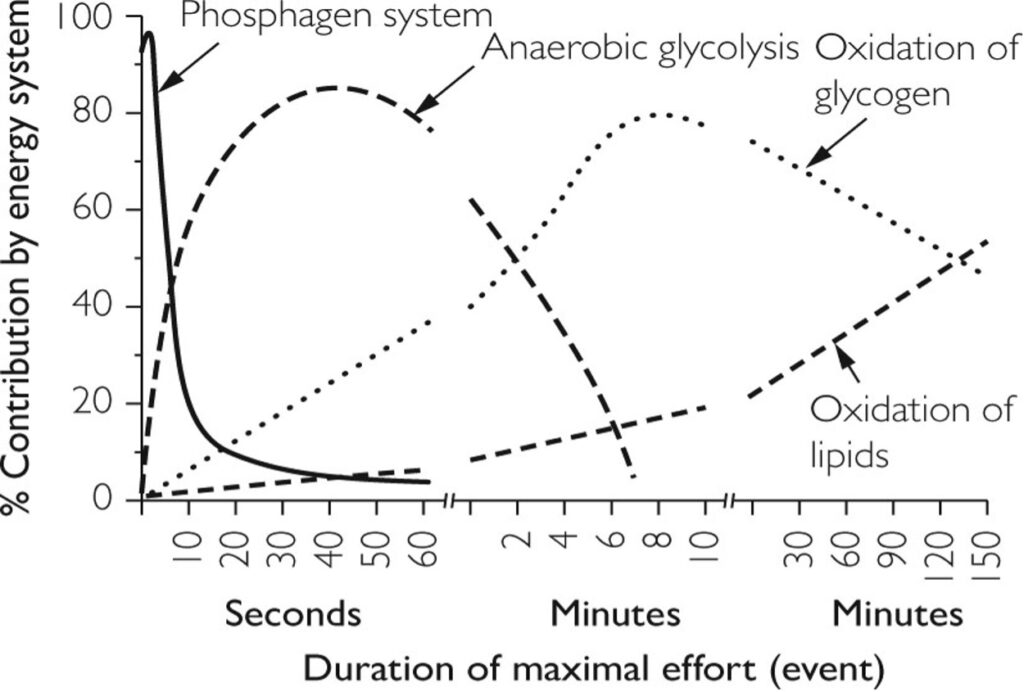
To the right is a graph showing the estimated contributions of each ES during indoor climbing13. This study was done on a small number of climbers, half were categorized as “Elite Level” and the other half “Recreational.”
Both groups underwent upper extremity power testing on an arm bike and were asked to climb an “easy” (5.10a), “moderate” (5.11b) and “hard” (5.12b) route where their VO2max was monitored during climbing. The authors concluded that the main energy systems used were the Aerobic and Anaerobic Alactic systems, and that training status, route difficulty and upper body power do not directly affect the contributions of these energy systems.
This study may seem to give us an idea of the dominant pathways being used; however, three things should be noted:
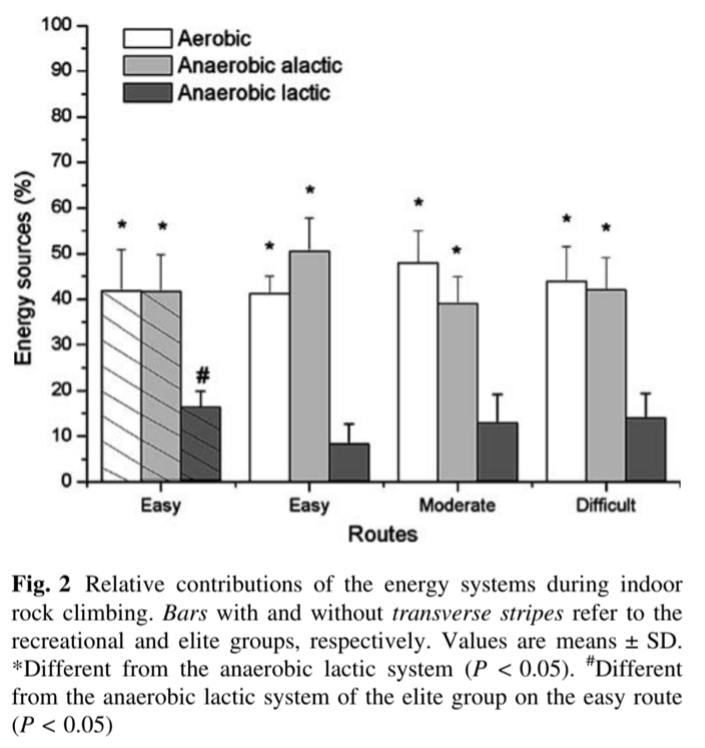
- Easy-moderate-hard are relative especially when comparing elite to recreational climbers;
- Lactate measurements were taken from the climbers’ ears, not their forearms (we won’t even start the discussion about whether lactate is correlative or causative of fatigue);
- VO2max is a measurement for cardiovascular fitness, and we know based on other studies that climbers are rarely, if ever, limited by their cardiovascular fitness when climbing1, 4, 6.
In fact, training studies focusing on improving VO2max have shown that previously sedentary subjects have a max improvement of about 15-20% and physically active individuals will have a max improvement of only about 10%12. So even if cardiovascular fitness did have a significant effect on your climbing abilities, you would have to spend a large amount of your training time for relatively minimal gains. This brings up the problem with studies done on EST in general and why it is so hard to apply the findings to training for rock climbing. The information is based on the energy systems being used systemically, or by the whole body, during a sport. With EST for rock climbing, we are focusing primarily on the energy systems used by our local hand/forearm muscles, and to my knowledge there is no research, or no high-quality research, done on this, leaving us to take general training principles and apply them the best we can to our specific training practices. In other words, the training protocols discussed in this article are guidelines, like the Pirate Code. In addition to using specific intensity and volume parameters, we are going by how our forearms FEEL while we are performing these exercises, so unfortunately there is a big subjective element involved in this type of training for climbing.
With EST we focus on developing 4 different components within the metabolic pathways:
- Anaerobic Power (Anaerobic Alactic): Strength and Power
- Anaerobic Capacity (Anaerobic Lactic): The “Strength” in Strength-Endurance (also referred to as Power-Endurance) Training
- Aerobic Power (Anaerobic Lactic + Aerobic): The “Endurance” in Strength-Endurance Training
- Aerobic Capacity (Aerobic): Long Duration Endurance Training
A quick and dirty way of explaining and understanding POWER vs CAPACITY is imagining a car’s fuel tank and engine. CAPACITY would be the tank with input pipe for the fuel, and POWER would be the engine and output pipe from the tank to the engine. Increasing CAPACITY would be similar to increasing your car’s input pipe and tank, thus increasing the amount of fuel your car can take in, hold and have available for use. Increasing POWER would be equivalent to increasing the size of the pipe from the tank to the engine and the engine itself, thereby increasing the amount of fuel delivered to the engine and the amount of power the engine can generate. Now, this is a very simplistic way of thinking about how these energy systems work, because in reality, during all types of training all metabolic pathways and training components are being utilized at varying degrees, but it gives you an idea of what these words are being used to refer to.
As stated before, we have guidelines for training intensity that we can apply from research on other sports to training each ES component, however, we are also going to go by how our forearm muscles FEEL. Below we again go through each type of training, and this time we will add a descriptive word that gives you a quick and immediate reference to what each type of training should feel like, followed by more detail on the guidelines for how to train each ES. I also want to re-emphasize that this is an article on how to train with limited resources, meaning basically with just a hangboard. There are many on-the-wall training drills for developing these ES components that we are not going to discuss, because it is not the point of the article.
- ANAEROBIC POWER: “PULL/JUMP”
- Strength (PULL)
- Intensity: ~85-95% of your 1 rep max (1RM)
- Hold Time: <10 seconds
- Sets: 2-6
- Reps: 1-5
- Rest between Sets: ~2-5 minutes
- Total Time Under Tension Goal (TUT): ~30-90 seconds
- Hangboard Examples:
- 3-5 sets, 3 reps, 3s on 5s off, 4-5 min rest b/w sets, TUT: 27-45s14
- 2 sets, 3-5 reps, 5s on 10s off, 2 min rest b/w sets, TUT: 30-50s14
- 2-5 sets, 3 reps, 7s on 53s off, 3 min rest b/w sets, TUT: 42-105s15
- 2-6 sets, 1 rep, 10s on, 3 min rest b/w sets, TUT: 20-60s16
- Power (JUMP)
- Intensity: Max effort under the below time constraints with a target of ~75-80% 1RM for higher intensity or ~40-70% for lower
- Hold Time: 1-3 seconds (focus should be on speed of contraction)
- Sets: 3-5
- Reps: 3-5 for higher intensity or <12 for lower intensity (or until pulling force drops below targeted percentage range)
- Rest between Sets: ~2-5 minutes
- Hangboard Examples:
- 75-80%, 3 sets, 5 reps, 3s on 10s off, 3 min rest b/w sets14
- Power focused maybe more for bouldering or hard crux moves on lead
- 50-60%, 4 sets, 12 reps, 3s on 10s off, 3 min rest b/w sets
- Power training possibly best suited for sport climbing
- What this training is used for: Short, severe boulders, power/campus moves, maximum strength, physical crux moves, deadpointing and dynamic moves.
- How You Should Feel: PULLING hard and slow or JUMPING hard and fast
- 75-80%, 3 sets, 5 reps, 3s on 10s off, 3 min rest b/w sets14
- Strength (PULL)
- ANAEROBIC CAPACITY: “POWERED-OUT”
- Intensity: ~65-85% 1RM
- Hold Time: 7-40 seconds, or to muscle failure
- Sets: 3-6
- Reps: 1-6
- Rest between Sets: ~3-5 minutes
- Hangboard Examples:
- 65-75%: 3-5 sets, 1 rep, 20-45s or failure, 3-5 min rest b/w sets25
- Density Hangs for improving strength and tendon structure.
- 70-75%: 6 sets, 6 reps, 7s on 3s off, 3 min rest b/w sets25
- Shorter intense sections, or crux sequences lasting 30-90 seconds.
- 80-85%: 6 sets, 5 reps, 7s on 3s off, 3 min rest b/w sets25
- Crux sequences, boulder problems or harder sections lasting 30-60 seconds.
- What this training is used for: Long, difficult boulders/cruxes; roped climbing through long, pumpy sequences without rest. Improves more short-term strength-endurance.
- How You Should Feel: POWERED-OUT – failure on reps needs to be due to Power-Out NOT significant Pump.
- 65-75%: 3-5 sets, 1 rep, 20-45s or failure, 3-5 min rest b/w sets25
- AEROBIC POWER: “PUMPED”
- Intensity: ~50-60% 1RM
- Hold Time: 7-10 seconds
- Sets: 3-8
- Reps: >12 or until muscle failure
- Rest between Sets: ~4 minutes
- Hangboard Examples:
- 50-60%, 6 sets, 12 reps, 7s on 3s off, 4 min rest b/w sets25
- Improving metabolic adaptation at higher intensities with limited rest.
- What this training is used for: Ability to recover during brief rest periods when redpointing or between strenuous, pumpy climbs. Improves more long term strength-endurance.
- How You Should Feel: The arm shattering, ‘I can’t make a fist’, ‘Screaming Barffies’ type of PUMP.
- 50-60%, 6 sets, 12 reps, 7s on 3s off, 4 min rest b/w sets25
- AEROBIC CAPACITY: “BORED”
- Intensity: ~40-45% 1RM
- Hold Time: 7-10 seconds
- Sets: >10
- Reps: >6
- Rest between Sets: ~1 minute
- Hangboard Examples:
- 40-45%, 10 sets, 6 reps, 7s on 3s off, 1 min rest b/w sets25
- What this training is used for: Local endurance; long climbs, all day stamina; allows you to clear the pump with good rests and get more out of shorter rests. Low intensity, high volume training, with short rest periods.
- How You Should Feel: BORED… Low pump level – if there is any pump, it is quick to fade with a 1-2 min rest.
That’s a lot of numbers and information; what do we do with it? Many of these routines can be easily found on influencer platforms, and I present these specific examples because the programming meets the guidelines, and they don’t take much time to do. The take-home message is that once you know the intensity and duration guidelines, as well as what you should be feeling during training, you can basically develop your own protocol to fit the needs of the type of climbing you’re training for. There is no magic hangboard protocol and a certain routine may be more successful for one climber and not so for another. That’s where regular assessment comes in, because if you’re not assessing, you’re guessing. Furthermore, if you’re not assessing what your one repetition max is, you will not be able to accurately apply the intensity percentages presented above and may not be accessing the metabolic pathways or applying the right amount of stress to the tissues you’re wanting to train.
Your one repetition max can be calculated in 2 ways. You can hang from a traditional hangboard, performing max hold times, gradually adding or subtracting weight until you are able to hang for maybe 5-10 seconds max, with control, and maybe a several second margin. This method can get tedious, and if it takes you several repetitions to find your max weight, you are accumulating fatigue with each attempt and the result may not be as accurate. Probably a more efficient and precise method is using one of the dynamometers which have become more popular and affordable in recent years, such as the Tindeq Progressor (https://tindeq.com/) or some type of crane scale with a high sampling rate. A device like the Tindeq has a useful corresponding app that includes a repeater program with real time graphs that you can set the parameters for on your own. And with each training session, you can perform a max force test to anchor that day’s training intensity. This means that rather than using a test result from 3-4 weeks ago, you can have an accurate result before each session. Be sure to train on the same edge depth you test on, as the force reading you get will be specific to that edge.
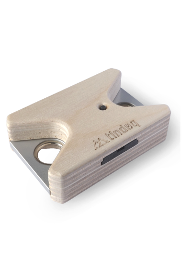
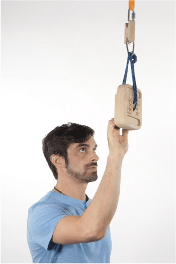
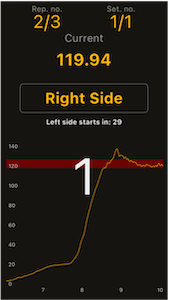
In general, without getting into the minutiae of exercise programming, you could train each of these systems 1-2x a week (maybe 3 if this is the only type of training you’re doing) using linear 3-4 week blocks (Anaerobic Capacity and Aerobic Power are usually trained in the same block when Strength-Endurance is the focus) or a non-linear periodization schedule; neither have been shown to be superior to the other. However, both have been proven to be more effective than no structured programming at all17. Higher percentage 1RM routines (such as those for PULL and JUMP) will have much less repetition volume because you will not be able to maintain that level of intensity for too long. Lower intensity protocols will conversely be higher volume, again performed until you can no longer maintain the target 1RM percentage. These high-volume routines such as POWERED-OUT and PUMPED should not be performed for long linear blocks, and not on consecutive blocks so as to prevent causing an overuse injury, but could potentially be maintained for longer periods if using a non-linear program.
I will state that I do NOT think all climbers need to train all these components. You should perform a “needs analysis” for the style of climbing you are doing. All climbers should be doing some type of Max Strength training, but if you are predominantly a boulderer, do you really need to train Aerobic Capacity? I would argue that you do not; in fact, I don’t think that sport climbers need to focus much attention on this either. Both bouldering and sport climbing appear to rely more on the Strength, Power and Strength-Endurance systems5, 6, 7, 8, 10. Many climbers will perform very high volumes of Aerobic Capacity, or ARC (Aerobic Restoration and Capillarity) training, and some sources recommend 20-45 minutes of very low intensity climbing up to 3 times a day, for most days of the week18; this is why the word BORED is used to describe how you feel doing it .
The science informing this type of training is that you are increasing the number of mitochondria in your forearm muscles to help with aerobic respiration and energy production. The problem is that most people just end up traversing around the gym, likely not reaching the proper level of intensity (or exceeding it), building up fatigue, claiming it’s their warm-up and that they are working on skill/footwork; then, they start their limit bouldering or redpoint session. In my opinion, this is just increasing your chances of developing an overuse injury and taking away from your time doing more productive training. Also, most experienced climbers, arguably, will not benefit from skill development at such a low level. When we refer to “endurance” training for rock climbing, we should clarify that it is Strength-Endurance development which should be the focus. Why do people choose ARC over Strength-Endurance training? My cynical side says: “because true Anaerobic Capacity/Aerobic Power training is hard and it hurts! And Aerobic Capacity training is easy and does not take much effort.” This is not to say that Aerobic Capacity training is useless, I just think training should be economical and efficient, applying the minimal effective dose yielding the best results for your selected goals, so that you can spend more time actually climbing and developing your skill.
Expanding on my earlier statement, “when you train at higher intensities, you are using both endurance AND strength muscle fibers”; there are no clean delineations between training zones and by doing Strength or Strength-Endurance focused work, you are still training Aerobic Capacity to some degree. Conversely, only working on Aerobic Capacity will not be intense enough to develop the other systems. Not convinced? Let me put this thought experiment out there: during a contraction, blood flow to your muscles becomes blocked at anywhere between 45-75% of your maximum voluntary contraction2, 6, 19, 20, 21. It is at this point that we will start to accumulate fatigue, feel PUMPED/POWERD-OUT, and we feel our grip force and endurance decline. Studies have shown that even small changes in Maximum Strength can have a substantial effect on muscle endurance, expressed by time to exhaustion19, 22, 23, 24. If Max Strength is increased, less muscle fibers would need to be recruited to perform work below that max, resulting in a greater number of fatigue resistant muscle fiber recruitment, delayed involvement of type 2 motor units, delayed or less arterial occlusion, and delayed onset of fatigue and force loss; basically, you will be able to climb harder, for longer with less pump.
Let’s wrap things up… it is very possible for climbers with limited resources, and arguably beneficial for all climbers, to perform focused Energy System Training off the wall using only a hangboard or a no-hangboard, preferably with a dynamometer. This type of training is all about making physiological changes, building/maintaining climbing fitness, and we want to separate our skill development from this because most of the time you should be working towards momentary muscle failure; doing this on the wall can potentially be dangerous— you will inevitably start to flail around, make wild movements, or fall in an uncontrolled way. It is important to keep climbing quality high, so your skill training should be challenging, but controlled so that you ingrain efficient motor patterns, learn how to use and move your body, and utilize long rest breaks between attempts. Those of us who have limitations related to time, access or other obligations can still maintain a very high level of climbing fitness with minimal equipment and time commitment, using the proposed guidelines. Hopefully, this will allow you, when you can make it onto a wall, to not be limited by strength or pump and allow for focused, high quality skill development, and of course fun.
References
- Sheel AW. Physiology of sport rock climbing. Br J Sports Med. 2004;38(3):355-359.
- Macleod D, Sutherland DL, Buntin L, et al. Physiological determinants of climbing-specific finger endurance and sport rock climbing performance. Journal of Sports Sciences. 2007;25(12):1433-1443.
- Hermans E, Saeterbakken AH, Vereide V, Nord ISO, Stien N, Andersen V. The effects of 10 weeks hangboard training on climbing specific maximal strength, explosive strength, and finger endurance. Front Sports Act Living. 2022;4:888158.
- Billat V, Palleja P, Charlaix T, Rizzardo P, Janel N. Energy specificity of rock climbing and aerobic capacity in competitive sport rock climbers. J Sports Med Phys Fitness. 1995;35(1):20-24.
- Watts PB. Physiology of difficult rock climbing. European Journal of Applied Physiology. 2004;91(4):361-372.
- Booth J, Marino F, Hill C, Gwinn T. Energy cost of sport rock climbing in elite performers. Br J Sports Med. 1999;33(1):14-18.
- White DJ, Olsen PD. A time motion analysis of bouldering style competitive rock climbing. Journal of Strength and Conditioning Research. 2010;24(5):1356-1360.
- Phillips KC, Sassaman JM, Smoliga JM. Optimizing rock climbing performance through sport-specific strength and conditioning. Strength & Conditioning Journal. 2012;34(3):1-18.
- Fanchini M, Violette F, Impellizzeri FM, Maffiuletti NA. Differences in climbing-specific strength between boulder and lead rock climbers. Journal of Strength and Conditioning Research. 2013;27(2):310-314.
- Arbulu A, Usabiaga O, Castellano J. A time motion analysis of lead climbing in the 2012 men’s and women’s world championship finals. International Journal of Performance Analysis in Sport. 2015;15(3):924-934.
- Baechle TR, Earle RW, National Strength & Conditioning Association (U.S.), eds. Essentials of Strength Training and Conditioning. 3rd ed. Human Kinetics; 2008.
- MacDougall JD, Sale D. The Physiology of Training for High Performance. Oxford University Press; 2014.
- Bertuzzi RC de M, Franchini E, Kokubun E, Kiss MAPDM. Energy system contributions in indoor rock climbing. Eur J Appl Physiol. 2007;101(3):293-300.
- Camp4 human performance. CAMP4 HUMAN PERFORMANCE.
- Training for climbing – by eric hörst – train smarter, climb harder! Training For Climbing – by Eric Hörst.
- López E. Fingerboard training guide (I). Preliminary evaluation. Fingerboard training guide (I). Preliminary evaluation | Eva López, PhD. Evidence-based Athletic Training for Climbing.
- Lorenz D, Morrison S. Current concepts in periodization of strength and conditioning for the sports physical therapist. Int J Sports Phys Ther. 2015;10(6):734-747.
- Anderson ML, Anderson ML. The Rock Climber’s Training Manual: A Guide to Continuous Improvement. First edition. Fixed Pin Pub; 2014.
- Østerås H, Helgerud J, Hoff J. Maximal strength-training effects on force-velocity and force-power relationships explain increases in aerobic performance in humans. European Journal of Applied Physiology. 2002;88(3):255-263.
- Devise M, Lechaptois C, Berton E, Vigouroux L. Effects of different hangboard training intensities on finger grip strength, stamina, and endurance. Front Sports Act Living. 2022;4:862782.
- Maciejczyk M, Michailov ML, Wiecek M, et al. Climbing-specific exercise tests: energy system contributions and relationships with sport performance. Front Physiol. 2022;12:787902.
- Hickson RC, Dvorak BA, Gorostiaga EM, Kurowski TT, Foster C. Potential for strength and endurance training to amplify endurance performance. Journal of Applied Physiology. 1988;65(5):2285-2290.
- Marcinik EJ, Potts J, Schlabach G, Will S, Dawson P, Hurley BF. Effects of strength training on lactate threshold and endurance performance. Med Sci Sports Exerc. 1991;23(6):739-743.
- López-Rivera E, González-Badillo JJ. Comparison of the effects of three hangboard strength and endurance training programs on grip endurance in sport climbers. Journal of Human Kinetics. 2019;66(1):183-195.
- Train like a pro. (n.d.). Crimpd. https://www.crimpd.com/
About the Author
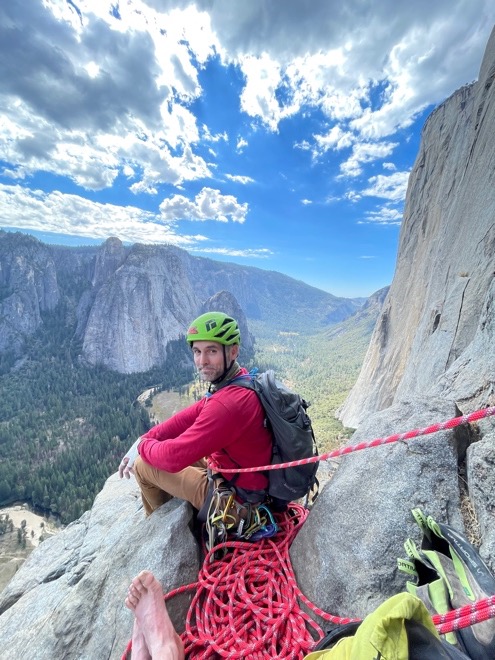
Steve Smith is a Doctor of Physical Therapy, who is a board-certified specialist in Orthopedic Physical Therapy, and Strength & Conditioning. He has been climbing since 2006 and has a particular interest in specialized sport training and rehabilitation, using science- and evidence-informed practice to improve performance and return patients and athletes to their highest level of athletic abilities. Steve works in an academic Orthopedic and Sports Medicine setting and, in his free time, acts as a training and injury risk reduction consultant to local competitive and recreational climbers. He currently lives in Huntington, WV and is developing The Mountain Athlete Clinic to more directly serve the climbing and adventure sport community.
Email: stephen.smith.dpt@gmail.com
Instagram: @themac.pt
- Disclaimer – The content here is designed for information & education purposes only and the content is not intended for medical advice.


